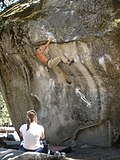Bouldering
Bouldering is a type of rock climbing. Bouldering comes without gear, belayer, and associated distractions. As such, it allows a climber to focus completely on the terrain and their movement. It is climbing heights at which the climber does not usually suffer serious injuries in case of a drop. To protect from injuries there are usually special bouldering mats underneath the climber. It is usually practiced on large natural boulders and in climbing gyms.[1]
Bouldering basics
Boulder routes are called "problems", because this style is like solving climbing-problems. The height of boulder problems is rarely higher than 3–5 metres (9.8–16.4 feet). Otherwise the risk of injuries is too high. Often other climbers, who stand on the ground, spot the climbers to protect them from hitting the ground with the head or the spine.
Equipment
The equipment used by boulderers is not much. They use special climbing shoes, a bouldering mat, some brushes to clean the grips and sports tape.
History
Bouldering was invented in the late 19th century. It has been first documented in France, England and Switzerland. It has been practiced for a long time but in the 1930s and 1940s it was practiced for its own sake in Fontainebleau in France.
Today many rock climbers are specialized boulderers and it is their favourite style of climbing.
Bouldering Media
Bouldering in Idyllwild, California
Bouldering in Hueco Tanks: Baby Martini (V6)
The largest outdoor bouldering gym in North America, The Cliffs at DUMBO, is located in Brooklyn Bridge Park.
A climber completing an indoor V3 problem
Climber on the Thimble in Custer State Park in South Dakota during the 1960s
John Gill on the Scab in the Needles of the Black Hills, 1963
Christian Core on Gioia (Varazze, ITA), first Template:Boulder grade boulder in history, 2008
Michael Rael Armas on Midnight Lightning, Camp 4 (Yosemite National Park, USA), one of the world's most famous bouldering problems
References
- ↑ Neyer, Eric. "Bouldering: What Is It and How To Start? (2022 Guide)". Climbing House. Retrieved 2022-04-30.







